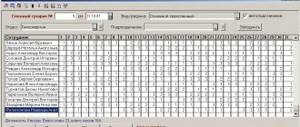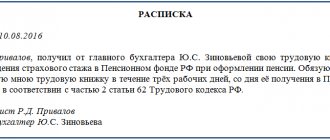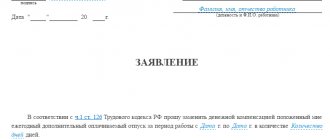07.07.2019
0
133
6 min.
Very often, when employees become pregnant, they do not inform the director about the change in their physiological status for fear of losing their job. But in most cases, technological factors can have a negative impact on the woman’s condition and the development of the fetus. For subordinates in production positions, the state guarantees a change in the working environment and comfortable working conditions. In order to preserve the health of the mother and not harm the unborn baby, the employer must provide her with easy labor during pregnancy, as enshrined in the Labor Code of the Russian Federation. Its provisions contain a list of functions and responsibilities that she is allowed to perform before going on maternity leave. In order to increase legal literacy, a woman should have an idea of the characteristics of production activities during this period and the amount of earnings.
Light labor during pregnancy
The exclusion of heavy functions is a mandatory condition that any woman preparing to become a mother has the right to take advantage of. Many people think that it is given only to workers who spend their working hours in workshops, at the machine, who are drivers of public transport, and who clean premises. But they are also mandatory for library employees, auditors, and trade workers, including office workers, who are surrounded by powerful technology that poses a danger to the development of an unborn child. Therefore, work is considered easy when not only there is no physical overload, but at the same time a calm, friendly, safe atmosphere is provided.
Basic Concepts
The Labor Code of the Russian Federation does not contain a definition of this term, but the legislator obliges management to reduce the productivity of a future maternity leaver or transfer her to an easy job that involves performing a minimum set of functions corresponding to her position. The basis is considered to be a medical report drawn up by the supervising gynecologist. He monitors the progress of the pregnancy, therefore, upon first request, he is obliged to issue a certificate reflecting the reasons why she will not be able to perform her usual work.
In this regard, the enterprise is obliged to change working conditions for pregnant women according to the Labor Code.
- It is prohibited to sit in front of a computer monitor or other office equipment for more than three hours a day.
- The negative impact of harmful factors on the female body should be completely excluded.
- Physical activity during work should be limited as much as possible.
- A ban is established on performing work activities near sources of bacterial infection, fungi, and viruses that can harm the health of the mother and child.
- Unfavorable conditions in the workplace are excluded: nervous overstrain, drafts, low or high room temperature, lack of fresh air and natural light.
Attention! If management violates its obligations, the employee has the right to refuse to perform official functions until the situation is corrected or transferred to another position.
The woman must provide the boss with a medical certificate from the housing complex and an application. It confirms the fact that this step was carried out by mutual consent and has legal force. Without this form, the director cannot transfer her to another field of activity. A pregnant woman must understand that her transfer or removal from her duties is temporary, and on the date she goes on maternity leave she will be automatically reinstated in her previous position.
Legal standards
The legislation of the Russian Federation provides for a wide range of articles and orders that allow a pregnant woman to work without stress and fatigue.
- Art. 254 Labor Code of the Russian Federation.
- ST. 259 of the Ore Code.
- Art. 261ТК and form No. 084/у Order of the USSR Ministry of Health
- Art. 4 SanPiNa.
- “Hygienic recommendations for the employment of pregnant women”, approved by the State Committee for Sanitary and Epidemiological Supervision and the Ministry of Health of the Russian Federation in December 1993.
Employer Responsibilities
As soon as a pregnant employee brings the HR officer or director a certificate from the Housing Committee, the latter must respond by eliminating all factors that could negatively affect the health of the mother and her unborn baby. This is his main task. At the same time he is obliged:
- create favorable conditions at the place of employment in accordance with established standards;
- let the subordinate go home, temporarily suspending her from work, but maintaining the average salary, if no other vacancy is expected;
- pay for the days when the employee is at home on sick leave or in the hospital.
Terms of payment
Remuneration in accordance with the new conditions also has certain features that must be taken into account by the employer.
- If the monthly salary in a new position is lower than the previous one, the director is obliged to pay the full salary, making an additional payment in the form of an allowance.
- When the salary in a new place is higher than the previous one, it is indicated in the additional agreement.
- If the position remains the same, but only the production load is reduced, then earnings should not be lower than the average for the previous period.
Legislation grants a pregnant woman the right to work part-time or a shortened week. In this case, the amount paid must correspond to the time worked. All costs associated with paying employees in an “interesting situation” are borne directly by the employer, since the Social Insurance Fund is not obliged to reimburse expenses of this kind.
How long can a pregnant woman work?
The employer is absolutely not obliged to voluntarily reduce the working hours for a pregnant employee if everything is in accordance with the norm. The main thing is that her schedule fits into the above hygiene recommendations, and she does not work overtime, on holidays and weekends.
The Labor Code does not establish how many hours of light work during pregnancy an employer may assign; the period of work should not exceed the norm provided for by law. For a normal working week, the norm is 40 hours (Article 91 of the Labor Code of the Russian Federation). An employee expecting a child should not work more than 8 hours a day, with two days off per week. And at the request of the employee, he will also be laid off.
During the entire period, she is allowed to work less and go to the clinic as much as necessary. The law does not limit her in this. For hours of forced rest due to medical examination, she is required to pay the average salary (Part 3 of Article 254 of the Labor Code of the Russian Federation). Naturally, this only applies to the conscientious attitude of the pregnant woman. If you suspect abuse, ask for a doctor's certificate. But keep in mind that the law does not oblige her to notify her employer about visiting the doctor. And the lack of certificates is not a basis for withholding money.
Features of light work in different areas
In addition to changing working conditions in the workplace, the boss must ensure that the pregnant woman is protected from performing prohibited actions:
- did not lift a load from the floor;
- did not hold heavy objects above the shoulder girdle;
- did not tilt more than 15°;
- did not perform monotonous actions;
- did not come into contact with harmful chemicals and toxic substances.
The director does not have the right to involve her in work at night, weekends and holidays, send her on business trips, or call her to work overtime. The employee should not experience psychological and emotional stress. During her shift, she needs to be in a comfortable position and be able to move and change body position.
In this regard, the employer is obliged to schedule an inspection and determine the degree of harmfulness of the work being performed. If the working conditions class is 3.1 or higher, this means the presence of harmful factors and requires a change of position. These restrictions apply to most professions and specialties, however, there are jobs that are not classified as dangerous, but are not suitable for women during pregnancy.
Trade and medicine
We are talking about sellers of household chemicals and laboratory employees who come into contact with harmful compounds and antiseptic solutions. When issuing a certificate for transition to light work, a woman expecting a child is obliged to describe her work functions to the doctor so that he can more accurately formulate the basis for revising his place of work and position.
Education
The work of teachers is considered specific because it involves the occurrence of stressful situations and psycho-emotional stress that are undesirable during pregnancy. In this regard, she has the right to obtain a medical certificate and demand a reduction in teaching hours.
Financial institutions
The issue of the adverse effects of office equipment on the body of a pregnant woman still remains controversial. According to experts, modern equipment virtually eliminates the negative impact on the health of the mother and the development of her fetus. However, this fact can only be accurately revealed during an inspection. Therefore, the employer has the right to compromise and limit a woman’s time in front of the monitor, reducing it to three hours per shift. For the rest of the time, he is obliged to offer another job that is not related to office equipment.
Legislation
Many enterprises and positions cannot provide safety and favorable conditions for fetal development. In this regard, the Labor Code of the Russian Federation introduced the concept of “light work for pregnant women” - this is a certain restriction on production standards and other indicators of the work process for pregnant women.
Transfer to light work is carried out upon declaration of pregnancy. The new area of activity must meet the requirements of labor legislation and eliminate the risk of exposure to negative production factors on the employee and her child.
As a rule, light work involves a new position in the professional field that does not require large physical expenditures and does not have harmful factors.
The law also obliges to maintain the amount of wages after the transfer and until going on maternity leave.
According to the Labor Code of the Russian Federation, pregnant employees are prohibited from performing the following types of work:
- lifting weights or any objects above the head;
- work on a production line;
- working under stress and constant neuro-emotional tension;
- contact with pathogens of certain diseases, as well as toxic chemicals;
- contact while working with infrared radiation;
- work in an enterprise with constant pressure drops;
- work with radiation, etc.
Despite the harm of these factors, the employer is not obliged to provide light work without presenting a medical report.
Term of transition to light work and end of period
Not a single document specifies specific dates for transferring pregnant women to light work. Depending on the working conditions and the complexity of the functions performed, this can happen at any time. This measure also depends on the employee’s health status and how her pregnancy is progressing. All this is reflected in the document issued by the gynecologist of the LC. Some try to get a certificate after the examination, others at 21-22 weeks.
It is important to know! However, the expectant mother is provided with work in a comfortable environment temporarily until the day she goes on sick leave under the BiR. If she is entitled to a scheduled vacation, she has the right to first take it off, and only then go on maternity leave without returning to the workplace. The basis in both cases is a written statement.
There are a number of other circumstances that may lead to the cancellation of an order to change the working conditions of a future maternity leave. One of them is the restoration of the previous schedule before going on sick leave according to BiR. The basis is a medical report from a doctor stating that her health allows her to work as usual.
How to apply
Registration of light work for a pregnant employee occurs according to the following algorithm:
- Submission of documents. An employer can transfer an employee to light work only upon presentation of a corresponding application and a medical certificate, which reflects the fact of pregnancy and the recommendations of the attending physician. A medical report is issued according to form No. 084/у. In addition to the need to transfer to simplified working conditions, it indicates factors that may be unfavorable for the expectant mother. The application is written in any form by hand and recorded in the internal documents register.
- Job offer. After considering the application, the employer must offer the employee a list of vacancies available at the enterprise that correspond to the classification of light labor and the employee’s qualifications. Since the salary at the new place cannot be less than at the previous job, the employer must indicate the difference with a bonus. For example, if the salary in the previous position was 30 thousand rubles, and in the new one - 24 thousand rubles, then the bonus will be 6 thousand rubles. According to labor laws, it is impossible to pay a lesser amount. After drawing up the proposal, the employee familiarizes herself with it against signature. Sample proposal:
- Obtaining consent. If a suitable vacancy has been found at the enterprise, the employee must give written consent to the transfer. Usually a corresponding statement is written. Some allow a simple signature on the job offer document.
- Drawing up an additional agreement. Drawing up an additional agreement is a mandatory condition for the transfer. It specifies new working conditions and return to the previous position, indicates the amount of wages and the validity period. The document is drawn up in two copies, one of which is attached to the employment contract, and the other remains with the employee. Sample agreement:
- Drawing up an order. The order is issued by the employer on the basis of a drawn up agreement. The document must indicate:
- deadline and reason for the transfer;
- new position;
- salary size;
- grounds for the procedure.
The employee reads the order against signature. A copy of the document can be provided upon request for further evidence of other work being performed. There is no need to make an entry in the work book about the transfer, since after returning from maternity leave the employee will return to her original duties.
The transfer period ends on the last day before the employee goes on maternity leave. This fact must be recorded by the employer in the appropriate order.
If a vacancy suitable for light work is not available at the enterprise, then the employer can introduce a new position specifically for a pregnant employee. After going on maternity leave, the position may be abolished at the discretion of management.
If there is no need for a new position, the employer releases the employee from her work duties with payment of a monthly salary.
Is it possible not to transfer to light work?
By law, the director must create comfortable working conditions for pregnant women in accordance with the labor code. Knowing this, every employee is confident that by submitting a certificate from the housing complex, she will work without stress in favorable conditions for as long as she wishes, or will temporarily stop working, receiving a full-size salary while sitting at home. By making such a decision, the company's management is obliged to place a new employee in her place, enter into a fixed-term contract with him, and actually pay for the same functions twice, which is extremely unprofitable for the enterprise.
Therefore, if the director doubts the advisability of transferring to light work, and has good reasons for this, he has the right to check the conditions and mode of work before agreeing to this step. The reason for refusal may be the absence of specific circumstances, namely:
- no need to lift heavy loads;
- is not involved in monotonous conveyor-type work;
- the duties are so simple that they do not cause physical strain or stress;
- contact with harmful and toxic substances is not expected.
Computer work is considered a sufficiently compelling reason for refusal to provide the most lightweight functions. Many subordinates who are expecting a child present as an argument the assertion that spending a long time in front of a monitor is a dangerous factor. However, the degree of harm can be determined by the results of medical examinations. In addition, modern technology is recognized as secure, since liquid crystal displays are used everywhere. This conclusion is confirmed by Letter of the Ministry of Labor No. 15-1/OOG-3481 dated September 27, 2016. It states that all PCs that have compliance certificates are considered safe. To avoid conflict, the employer has the right to propose drawing up a new work contract for working remotely. Registration will take some time, but the woman will be able to be in any place convenient for her, even at home.
What benefits are provided?
The Labor Code protects the rights of expectant mothers, including those who get a job during pregnancy.
Basic labor benefits for pregnant women:
- Employment of pregnant women occurs without a probationary period (Article 70 of the Labor Code of the Russian Federation).
- An employer cannot refuse a job to an applicant because she is pregnant. Moreover, he cannot ask questions about her situation. The only reason for refusal to work is an insufficient level of qualifications for the position. If the reason for the refusal was a fictitious excuse, the woman can ask for a written answer and contact the labor inspectorate with it. Identification of an unreasonable refusal to provide employment will entail sanctions.
- An employer cannot fire a pregnant employee, including under Art. 81 of the Labor Code of the Russian Federation (for violating the schedule, absenteeism, etc.).
- The employer is obliged to provide the pregnant woman with light work upon presentation of the appropriate medical certificate. It is important that the certificate indicates specific restrictions on work activity.
- The employee is exempt from work on weekends and holidays, as well as on night and overtime shifts.
- A pregnant woman can take annual paid leave at any time. Even if it was not her turn, or she did not work for a certain period. For example, you can take a vacation before the start of maternity leave or immediately after it.
- Light work for pregnant women according to the Labor Code in 2021 implies a ban on working on a rotational basis (Article 198 of the Labor Code of the Russian Federation).
- A pregnant woman has the right to be excused from work duties on weekdays to undergo a scheduled examination. In the case of a difficult pregnancy and frequent examinations, it is necessary to take the appropriate certificate from the antenatal clinic and register it with the human resources department. If necessary, the employee may leave the workplace. Regardless of how many hours per day are actually worked, the employer is required to retain earnings for the entire day.
- In addition to the lunch break, the expectant mother has the right to receive short breaks during the working day.
- It is prohibited to transfer a pregnant woman to another position without her consent.
- An employer is required to provide a pregnant employee with paid maternity leave. The duration of the leave depends on the course of pregnancy and the complexity of childbirth.
Benefits may also be provided to the husband of a pregnant employee. Regardless of his length of service, he can take advantage of annual leave during his wife’s pregnancy and childbirth.
What documents are needed for translation?
In order for the application for transfer to light work to be accepted by the employer, it is important to support it with a document confirming the fact that circumstances have arisen that require changes in the employee’s working conditions.
This is a medical report on the state of health.
State medical institutions issue documentation of this type. The specificity of their focus depends on the specific situation.
For example, if a transfer to another position is due to pregnancy, a certificate from the Housing Committee is attached to the application.
Based on these documents, the employer issues an order.
Registration during pregnancy
Pregnant women have the right to apply for transfer to another position. When performing official duties in this case, certain rules must be observed:
- reduction in production standards;
- absence of influence of factors that negatively affect the condition of the mother and baby;
- maintaining average earnings.
The first stage of translation is the preparation of the appropriate application. It is drawn up in free form, because there is no unified form for filling it out.
The application must contain the following information:
- name of the addressee - name of the company, full name of the general director;
- the initials and position of the applicant, which he occupies at the time of submission of the document;
- full name of the document (written in the middle of the line);
- request for transfer light labor;
- a document acting as a basis - a link to a medical report, indicating its number and date of issue;
- the period during which a woman must work in more comfortable working conditions (in most cases before the start of the labor and employment leave);
- a list of factors whose impact should be limited;
- reference to a normative act regulating the right of a pregnant woman to transfer to light work - Article 254 of the Labor Code of the Russian Federation;
- application;
- date of application;
- signature and initials of the employee.
An application of the specified sample can be submitted at any time. The only obligatory condition for its submission is the presence of a medical report.
from a pregnant woman
Applications to transfer a pregnant woman to light work while maintaining average earnings - word.
For health
In general, a statement of this type, which is drawn up due to the identification of health problems, is similar to a document issued during pregnancy.
Some changes are present only in the main part of the paper.
In this section of the application, you must indicate the reason why transfer to light work is required.
As in the previous case, a medical report must be attached to the application.
In addition, it is important in the document to reflect the duration of the period during which the employee needs to work in more comfortable conditions.
Information of this nature is reflected in the certificate issued by the medical institution. The duration of this time is different in each case and depends on the specific situation.
The form must also include a reference to the relevant article of the Labor Code of the Russian Federation, the applicant’s signature and the date of submission of the document.
Example
applications for transition to easy working conditions based on a medical report - word.
Responsibility for violation
An employer does not have the right to refuse to transfer a pregnant woman to light work if she has provided a medical certificate about such a need.
If refused, the pregnant employee may go to court. In almost every case, the judge remains on the side of the plaintiff. In this case, the court obliges the employer to offer the employee other positions during pregnancy or send her on leave with pay if there are no vacancies.
In cases where the employer offered a vacancy, and the employee refused it, it is still impossible to fire the pregnant woman. The employer will have to find another vacancy or send the employee on vacation.
Termination of an employment contract is permissible only in the event of liquidation of the organization and the expiration of the employment contract. In this case, termination at the end of the agreement can only be formalized if the employee officially refuses the offered position.
Thus, the employer must provide the pregnant employee with easy working conditions upon presentation of a medical report. It is important that the conclusion is not a simple medical certificate and must be drawn up in accordance with all standards. Only then can the employee count on the transfer.
Conditions
The work of a pregnant woman, regardless of what field she works in, must meet the conditions specified by law. So, in industry, if the activity is related to assembly, sorting, packaging, operations must be automated. At the same time, the employer is obliged to take care of sufficient lighting in the room to prevent eye strain. Light work during pregnancy should completely eliminate increased emotional stress.
A pregnant woman should not work in a draft, with wet clothes and shoes, or with sudden changes in pressure. It should not be exposed to harmful chemicals, aerosols, vibration or ultrasound. During pregnancy, a woman is strictly prohibited from engaging in activities related to pathogens.
The employer is obliged to provide such working conditions that will eliminate the need for an employee to constantly remain in the same position during pregnancy (constantly sitting or constantly walking is prohibited). Also, work cannot be performed in a squatting, kneeling, bending position, or focusing on the stomach or chest.
The professional duties of a pregnant employee cannot be associated with lifting objects from the floor, above shoulder level, or straining the abdominal muscles. A pregnant woman can lift weights (no more than 2.5 kg) no more than 2 times per hour. If such frequency cannot be observed due to technological conditions, then the weight is reduced by half. But within an hour the total weight can be no more than 6 kg. In general, the weight of the load during a shift should not exceed 48 kg.
When performing piecework work, the production rate is reduced by 40%. However, pay for light work during pregnancy is not reduced. If a woman works in agriculture, then during pregnancy she is exempt from work related to livestock and crop production. Moreover, this applies from the first day of confirmation of pregnancy.
Working conditions in the office imply the right of a woman not to work with computers. If this is not possible, then work time should be reduced to 3 hours a day. For women, there is a corrugated footrest and a chair that meets special parameters: rotating, with a headrest, armrests and a high back, which must be adjusted in height.











